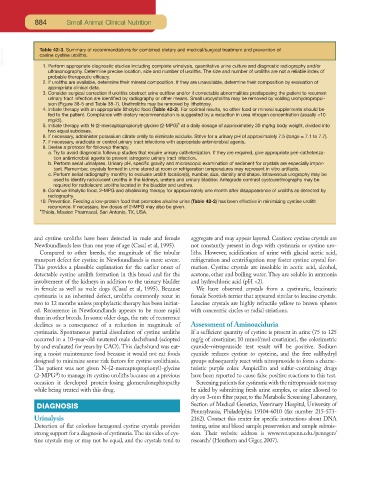Page 853 - Small Animal Clinical Nutrition 5th Edition
P. 853
884 Small Animal Clinical Nutrition
VetBooks.ir Table 42-3. Summary of recommendations for combined dietary and medical/surgical treatment and prevention of
canine cystine uroliths.
1. Perform appropriate diagnostic studies including complete urinalysis, quantitative urine culture and diagnostic radiography and/or
ultrasonography. Determine precise location, size and number of uroliths. The size and number of uroliths are not a reliable index of
probable therapeutic efficacy.
2. If uroliths are available, determine their mineral composition. If they are unavailable, determine their composition by evaluation of
appropriate clinical data.
3. Consider surgical correction if uroliths obstruct urine outflow and/or if correctable abnormalities predisposing the patient to recurrent
urinary tract infection are identified by radiography or other means. Small urocystoliths may be removed by voiding urohydropropul-
sion (Figure 38-5 and Table 38-7). Urethroliths may be removed by lithotripsy.
4. Initiate therapy with an appropriate litholytic food (Table 42-2). For optimal results, no other food or mineral supplements should be
fed to the patient. Compliance with dietary recommendation is suggested by a reduction in urea nitrogen concentration (usually <10
mg/dl).
5. Initiate therapy with N-(2-mercaptopropionyl)-glycine (2-MPG)* at a daily dosage of approximately 30 mg/kg body weight, divided into
two equal subdoses.
6. If necessary, administer potassium citrate orally to eliminate aciduria. Strive for a urinary pH of approximately 7.5 (range = 7.1 to 7.7).
7. If necessary, eradicate or control urinary tract infections with appropriate antimicrobial agents.
8. Devise a protocol for followup therapy.
a. Try to avoid diagnostic followup studies that require urinary catheterization. If they are required, give appropriate peri-catheteriza-
tion antimicrobial agents to prevent iatrogenic urinary tract infection.
b. Perform serial urinalyses. Urinary pH, specific gravity and microscopic examination of sediment for crystals are especially impor-
tant. Remember, crystals formed in urine stored at room or refrigeration temperatures may represent in vitro artifacts.
c. Perform serial radiography monthly to evaluate urolith location(s), number, size, density and shape. Intravenous urography may be
used to identify radiolucent uroliths in the kidneys, ureters and urinary bladder. Antegrade contrast cystourethrography may be
required for radiolucent uroliths located in the bladder and urethra.
9. Continue litholytic food, 2-MPG and alkalinizing therapy for approximately one month after disappearance of uroliths as detected by
radiography.
10. Prevention. Feeding a low-protein food that promotes alkaline urine (Table 42-2) has been effective in minimizing cystine urolith
recurrence. If necessary, low doses of 2-MPG may also be given.
*Thiola, Mission Pharmacal, San Antonio, TX, USA.
and cystine uroliths have been detected in male and female aggregate and may appear layered. Caution: cystine crystals are
Newfoundlands less than one year of age (Casal et al, 1995). not constantly present in dogs with cystinuria or cystine uro-
Compared to other breeds, the magnitude of the tubular liths. However, acidification of urine with glacial acetic acid,
transport defect for cystine in Newfoundlands is more severe. refrigeration and centrifugation may foster cystine crystal for-
This provides a plausible explanation for the earlier onset of mation. Cystine crystals are insoluble in acetic acid, alcohol,
detectable cystine urolith formation in this breed and for the acetone, ether and boiling water. They are soluble in ammonia
involvement of the kidneys in addition to the urinary bladder and hydrochloric acid (pH <2).
in female as well as male dogs (Casal et al, 1995). Because We have observed crystals from a cystinuric, leucinuric
cystinuria is an inherited defect, uroliths commonly recur in female Scottish terrier that appeared similar to leucine crystals.
two to 12 months unless prophylactic therapy has been initiat- Leucine crystals are highly refractile yellow to brown spheres
ed. Recurrence in Newfoundlands appears to be more rapid with concentric circles or radial striations.
than in other breeds. In some older dogs, the rate of recurrence
declines as a consequence of a reduction in magnitude of Assessment of Aminoaciduria
cystinuria. Spontaneous partial dissolution of cystine uroliths If a sufficient quantity of cystine is present in urine (75 to 125
occurred in a 10-year-old neutered male dachshund (adopted mg/g of creatinine; 10 mmol/mol creatinine), the colorimetric
by and evaluated for years by CAO). This dachshund was eat- cyanide-nitroprusside test result will be positive. Sodium
ing a moist maintenance food because it would not eat foods cyanide reduces cystine to cysteine, and the free sulfhydryl
designed to minimize some risk factors for cystine urolithiasis. groups subsequently react with nitroprusside to form a charac-
The patient was not given N-(2-mercaptopropionyl)-glycine teristic purple color. Ampicillin and sulfur-containing drugs
a
(2-MPG ) to manage its cystine uroliths because on a previous have been reported to cause false positive reactions to this test.
occasion it developed protein-losing glomerulonephropathy Screening patients for cystinuria with the nitroprusside test may
while being treated with this drug. be aided by submitting fresh urine samples, or urine allowed to
dry on 3-mm filter paper,to the Metabolic Screening Laboratory,
DIAGNOSIS Section of Medical Genetics, Veterinary Hospital, University of
Pennsylvania, Philadelphia 19104-6010 (fax number 215-573-
Urinalysis 2162). Contact this center for specific instructions about DNA
Detection of flat colorless hexagonal cystine crystals provides testing, urine and blood sample preservation and sample submis-
strong support for a diagnosis of cystinuria.The six sides of cys- sion. Their website address is www.vet.upenn.edu./penngen/
tine crystals may or may not be equal, and the crystals tend to research/ (Henthorn and Giger, 2007).

